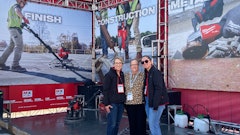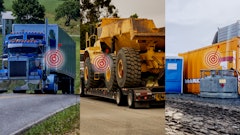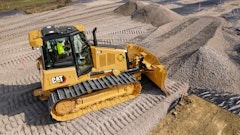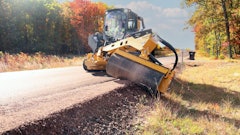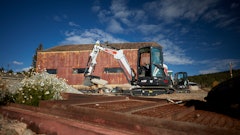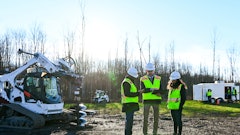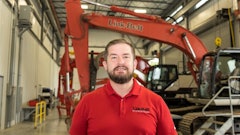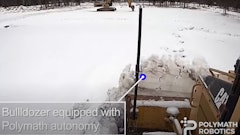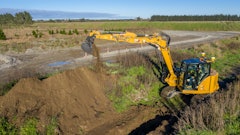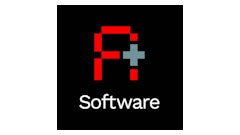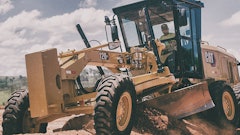
FCP: Help me understand the qualitative or quantitative improvement this has over previous generations?
Kevin Garcia (Trimble): What Roadworks does though, is it migrates to the to the newer platform, which is Android based. What's really cool about it as we're sitting here in this Trimble-slash-B2W booth is, you can be running B2W software and machine control software at the same time.
So if, for example, I'm standing on the mill, and one of my jobs is to track the number of trucks that are hauling the millings away, I can keep an idea of how many tons we've milled out. I'm using my machine control screen for now to manage that, that up-down-lleft-right of the mill, which I'm changing the profile or I'm optimizing the profile of the road for smoothness, material management, quality, QC type stuff. At the same time I could also just swipe right, and now I'm in my B2W track window. Okay, I've just hauled away another truck, that's another 20 tons going to this yard and then keep track of that.
Now, if I'm a vertically integrated customer who's got dirt moving solutions, milling solutions, and paving solutions, all of those are on the works platform, which means I can be moving the more expensive smart parts of the machine control system from machine to machine and maximize my investment.
Also, Roadworks migrating into the next generation will also allow us to do more with that kind of office-to-field workflow. So you can create your model, push it through works manager out into the field, it shows up on the tractor, you're not worrying about transferring USB sticks, you're always on the latest greatest model, because you're on a connected site. You can query the cloud, we can pull back the digital as-built data into the office. You can say, “Here's what we said we were going to build, and here's what we did build, and how closely those two things aligned.”
FCP: It creates a way to easily search or query the data or the metadata from those projects?
Garcia: Right.
FCP: What’s the biggest impact the 3D milling has on the roadwork itself?
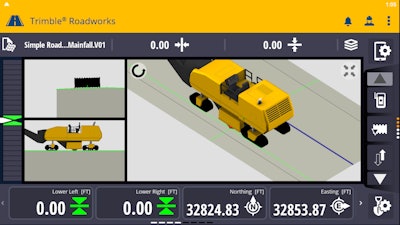
Garcia: I always say, “If Trimble doesn't sell anymore 3D asphalt pavers, because we're selling 3d Milling, we're doing it the right way.” Fix it with the mill. The mill is the easy machine to control.
Asphalt pavers have a floating screed just and are inherently more difficult. Things can go wrong, mix types can change, gradation of the mix can change, temperatures can change, material can run and the screed drops, or if you flood the paver the screed rises, even though that's not the intended outcome. But because of the floating nature of a screed, it's harder to control. A mill is a very fine thing, I know exactly where the drum tooth is at. I moved the cylinders up or down to put it where I want it, fix it with the mill. Okay, cool.
Say we're going to do a thin lift overlay on a job, I'm gonna go take an inch and a quarter off the top of the existing surface, and we're going to refill it with new asphalt. Great, sounds easy. And in most worlds, that means today you mill out about an inch and a quartee. If that surface is wavy, I'm still going to be wavy, I'm just going to be an inch and a quarter lower. Let's make it smooth.
FCP: The question I was that was popping into my head is: How do you fix it in the mill?
Garcia: [Grabs a notepad from a table and starts drawing]
 Brandon Noel
Brandon Noel
FCP: How do they turn that data into something actionable?
Garcia: I can start comparing my as-planned versus as-performed data. If it's not meeting standards, what happened? What changed? We know how many hours we were in the field, we know how much dirt we moved, and we know how much we paved. Why didn't it go according to plan? All the data is going to be there to teach you, you can start to hone in on what was that root cause, so that we don't do it again next time or that you bid accordingly so that it doesn't overrun.
It's also going to become a differentiator for certain levels of contractors. You can give the client a set of detailed information, so that if you ever decide to do a renovation later, it can tell you where the utilities are, it can tell you exactly how thick your asphalt is, it can tell you what the mix type was, in case you need to use that information later.
FCP: I think that the more that data is educational and actionable, I think that it's almost, it's as valuable as the tool on the day itself.
Garcia: I fully agree, I think you're gonna get to a world where the up-down-left-right of the machine is the commodity and the data of what we use will become invaluable.
FCP: Ultimately, the bleeding edge question is: How could artificial intelligent models take this data, this raw information, and process it algorithmically? Could it be able to tell us what we can learn from it in ways that are insightful that beyond our own ability to analyze?
Garcia: AI will play a future role with data processing. AI is interesting, especially in construction because this is a it's an orchestration of the job sites. It's not one machine does a task and leaves and I just measure that. It's lots of machines working together, I might have for dozers to excavators. It could potentially help modeling all that stuff, kind of almost digitally building the job before you build it. What if you could build a job before you ever put a single boot on the ground? That's the kind of stuff where you're on the cutting edge of the future
[This interview was edited for content and length.]







